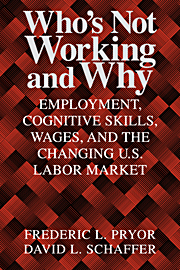Appendix Notes
Published online by Cambridge University Press: 25 March 2010
Summary
Chapter 1
Note 1.1: The Current Population Survey Data
The basic data for this book come from the Current Population Survey (CPS) for March of each year. We obtained 32 years of March CPS data (March 1964 through March 1995) from the Inter-University Consortium for Political and Social Research (ICPSR). In describing these annual data we borrow freely from descriptions published in ICPSR (1996).
The CPS is a household sample survey conducted monthly by the Census Bureau to provide estimates of the population as a whole and of various subgroups in the population. In addition to demographic characteristics such as age, sex, race, marital status, and household relationships, the CPS also provides data on employment status, occupation, and industry of persons 14 years of age and older. Data on labor force activity are provided for the week prior to the survey. The universe for the surveys is the civilian noninstitutionalized population of the United States living in households, from which a national probability sample of about 120,000 persons is selected.
The March survey, often called the Annual Demographic Survey, includes all of the usual monthly labor force data, plus detailed supplementary data on every adult's work experiences during the previous calendar year. The annual data include weeks worked, usual hours worked per week, and total earnings of each individual.
The data available for the earlier years are much sparser than for recent years. The samples are smaller – usually about 60,000 persons. The number of questions asked is also much smaller – perhaps only one-third as many as in recent years. Many of the quantity variables in these earlier surveys are “coded” into categories, rather than listed directly.
- Type
- Chapter
- Information
- Who's Not Working and WhyEmployment, Cognitive Skills, Wages, and the Changing U.S. Labor Market, pp. 234 - 279Publisher: Cambridge University PressPrint publication year: 1999



